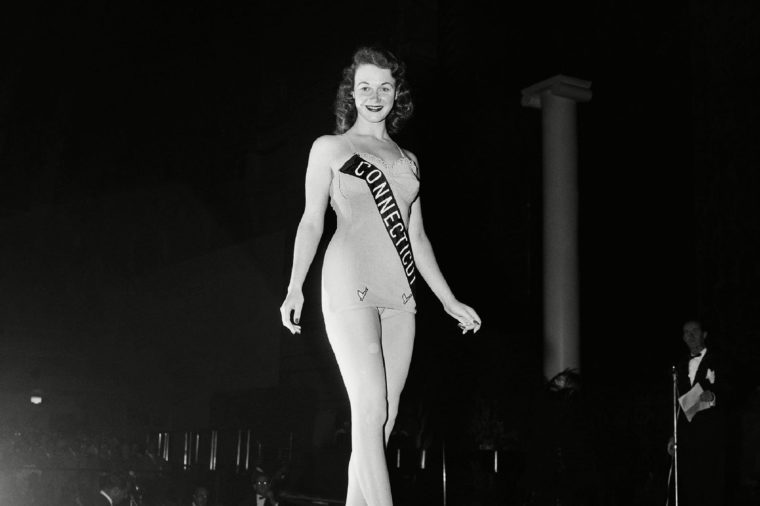20/06/2018

Sarah Madaus
For nearly 100 years, the Miss America pageant has reflected the ever-changing American culture.
1921: The beginning of an era

Margaret GORMAN 1905-1995, winner of the first Miss America pageant in 1921 at Atlantic City, New Jersey
The Art Archive/Shutterstock
In its inaugural year, the Miss America Pageant (which was then called the “Inter-City Beauty” contest) drove attention and revenue to the nine East Coast newspapers that founded it. The “Inter-City Beauties” were judged based on their personality and social graces after a day of mingling with judges and the public. The first winner, 16-year-old Margaret Gorman, hailed from Washington D.C.
1928: Or… the end of an era?

Bess Myerson, Helen Myerson, Sylvia Grace Miss America, Bess Myerson, center, poses with her two sisters, Helen Myerson, left, and Sylvia M. Grace, after walking off with the honors at the annual Beauty Pageant held at Atlantic City, N.J., . An accomplished flautist, she plans to use the $5,000 scholarship accompanying her title for the advanced study of music here and abroad
Sam Myers/Shutterstock
In a 27-3 vote, pageant organizers decided to fold the annual contest due to increasing pressure from women and church groups, as well as imminent financial issues.
1933: Back with a bang

Myerson Bess Myerson, of New York, holds the scepter after being crowned Miss America 1945 at the annual Miss America pageant in Atlantic City, N.J. Myerson, the first Jewish Miss America who parlayed her stunning 1945 victory into national celebrity, died Dec. 14, 2014, at her home in Santa Monica, Calif. She was 90
Uncredited/AP/REX/Shutterstock
Officials reinstated the annual contest, but this unrest was only a foreshadowing of the controversy it would continue to create over the next 75+ years.
1947: Little polka dot bikini

Renee Dianne Roy, Miss Connecticut, appears in bathing suit during preliminary event, of Miss America pageant on at Atlantic City, N.J
Marty Lederhandler/Shutterstock
The pageant reflected the cultural shifts of fashion and modesty; during this year, contestants began wearing two-piece swimsuits. This year was the first and last year that the winner was crowned in her swimsuit.
1954: Broadcasting live from Atlantic City

These women line the boardwalk at Atlantic City, N.J.,, where they are competing for the title of Miss America, 1952. The annual beauty pageant ends Sept. 8. Three of this group (front, center), Miss Sweden, Miss America 1951, and Miss Atlantic City, are not contestants
Uncredited/AP/REX/Shutterstock
As the media landscape shifted from radio to television in the early 1950s, the Miss America pageant also evolved to stay relevant. This year brought the first live TV broadcast of the contest, garnering 27 million viewers. This made the Miss America brand ubiquitous; everyone knew what it was and it became a definition of American culture and beauty.
1960: A household name

Lynda Lee Mead Lynda Lee Mead of Natchez, Miss., is shown during the swimsuit competition during the Miss America pageant in Atlantic City, N.J
Uncredited/AP/REX/Shutterstock
Eighty-five million people––an all-time high––tuned into the annual two-hour broadcast of the Miss America pageant.
1968: The rise of unruly women

Demonstrators from the National Women's Liberation Party picket with signs in protest of the annual Miss America Pageant in front of the Convention Hall in Atlantic City, N.J., on
AP/REX/Shutterstock
The ‘60s brought the rise of protests: against war, the government, and yes, even the Miss America pageant. Feminists gathered outside of the competition venue and protested by throwing their bras, girdles, curling irons, false eyelashes and other “instruments of female torture” into a trash can. They claimed that Miss America encouraged unrealistic beauty standards. We wouldn’t be surprised if you didn’t learn about this in history class –– or about these 9 other incredible women with empowering stories.
1973: Using her platform

King Rebecca Ann King, of Denver, Co., walks down the runway after she is crowned Miss America 1974 at the Miss America Pageant in Atlantic City, N.J., Saturday night
AP/REX/Shutterstock
The winner of the 1974 pageant, Rebecca King, received nationwide attention for her vocal pro-choice stance on abortion during the divisive Roe v. Wade decision year. Each year, the winner of the contest chooses a cause to champion, but King’s was by far the most controversial. Check out this list of 8 other inspiring women that are changing the lives of women across the world, just like King.
1974: Beauty… and brains

Miss America 1976, Tawny Elaine Godin of Saratoga Springs, New York, left, is crowned by Miss American 1975 Shirley Cothran, right, at the pageant in Atlantic City, N.J
Anonymous/AP/REX/Shutterstock
A law student crowned a doctorate student, and the “Modern Miss America” was born. She was smart, sophisticated, and eloquent. She was expected to be beautiful and driven. The common narrative of desiring marriage and childbearing transformed into one that encouraged careers, higher education, and success.
1983: It only took 50 years

Williams Vanessa Williams, representing New York State, is shown during her coronation walk holding the scepter after she is crowned Miss America 1984 at the Miss America Pageant in Atlantic City, N.J., on . Williams, of Syracuse, is the first African American to win the competition
JACK KANTHAL/Shutterstock
Vanessa Williams was the first African-American woman to be crowned Miss America in 1984, but she resigned shortly after Penthouse released nude photos of her to the public. The runner-up, Suzette Charles of New Jersey, became the second African-American woman to be crowned. Be sure to read about these 58 trailblazing women who made history, just like Williams.
1985: Nixing the measurements

Pictured on the beach in Atlantic City at the Miss America Pageant are from left: Suzette Charles, Miss N.J.; Vanessa Williams, New York; Jennifer Eshelman, Pa.; and Dakeita Vanderburg, Conn., shown
Jack Kanthal/Shutterstock
The pageant program book ran bust, waist, and hip measurements for the last time. This marked an enormous change, as the female body was meticulously studied and measured for the previous 50 years.
1994: DisABILITY

Heather Whitestone Miss America 1995 Heather Whitestone, the former Miss Alabama, walks down the runway and signs "I Love You" to the crowd after she won the 74th annual pageant in the Atlantic City Convention Hall
TOM COSTELLO/Shutterstock
Heather Whitestone, who had serious hearing loss, became the first Miss America with a disability. This transformed the narrative that Miss America had to be able-bodied in order to be a role model for other Americans.
2000: Changing cultural landscape

MISS AMERICA Former Miss America Heather French, top, crowns Miss America 2001 Angela Perez Baraquio, the former Miss Hawaii, during the Miss America pageant in the Atlantic City, N.J., Boardwalk Convention Hall
CHARLES REX ARBOGAST/Shutterstock
Angela Perez Baraquio was the first Asian-American woman to be crowned Miss America. As a competitor, she probably needed a lot of motivation to move through the challenging competition. Check out these 20 confidence-boosting quotes from impressive women in history.
2013: Fostering an accepting environment

Mallory Hagan, Nina Davuluri. Miss New York Nina Davuluri, front, is crowned as Miss America 2014 by Miss America 2013 Mallory Hagan, in Atlantic City, N.J
Mel Evans/Shutterstock
Nina Davuluri was the first Indian-American Miss America and represented her cause, cultural diversity.
2016: LGBTQ+ equality

Miss Missouri, Erin O'Flaherty waves as she is introduced during Miss America Pageant arrival ceremonies, in Atlantic City. The contestants from all 50 states, the District of Columbia and Puerto Rico were welcomed to the city Tuesday afternoon to kick off two weeks that will culminate in the crowning of the 2017 Miss America on Sept. 11
Mel Evans/Shutterstock
Erin O’Flaherty became the first openly lesbian contestant in the pageant. Her presence in the pageant represented another big step toward achieving equality and inclusivity.
January 2018: The aftereffects of #MeToo

Gretchen Carlson
Matt Baron/Shutterstock
Gretchen Carlson, a political journalist and former Miss America winner, was named Chair of the Board of Trustees. A handful of other women were elected to the board, replacing men after the explosive and revealing #MeToo movement in 2017. Since their election, the organization has undergone rapid (and welcomed) change.
June 2018: Bye, bye bikini

Miss America 1989 Gretchen Carlson
REX/Shutterstock
Gretchen Carlson called for the end of the swimsuit portion of the competition––which has been an integral part of the pageant structure since its creation. In a press release, the Board of Trustees wrote, “In its place, each candidate will participate in a live interactive session with the judges, where she will highlight her achievements and goals in life and how she will use her talents, passion, and ambition to perform the job of Miss America.” Regina Hopper, President and CEO, unveiled the new mission statement of the competition: ‘To prepare great women for the world, and to prepare the world for great women.’ Next, don’t miss these 10 empowering quotes from women in politics.
https://www.rd.com/culture/miss-america-pageant-changes-history/
